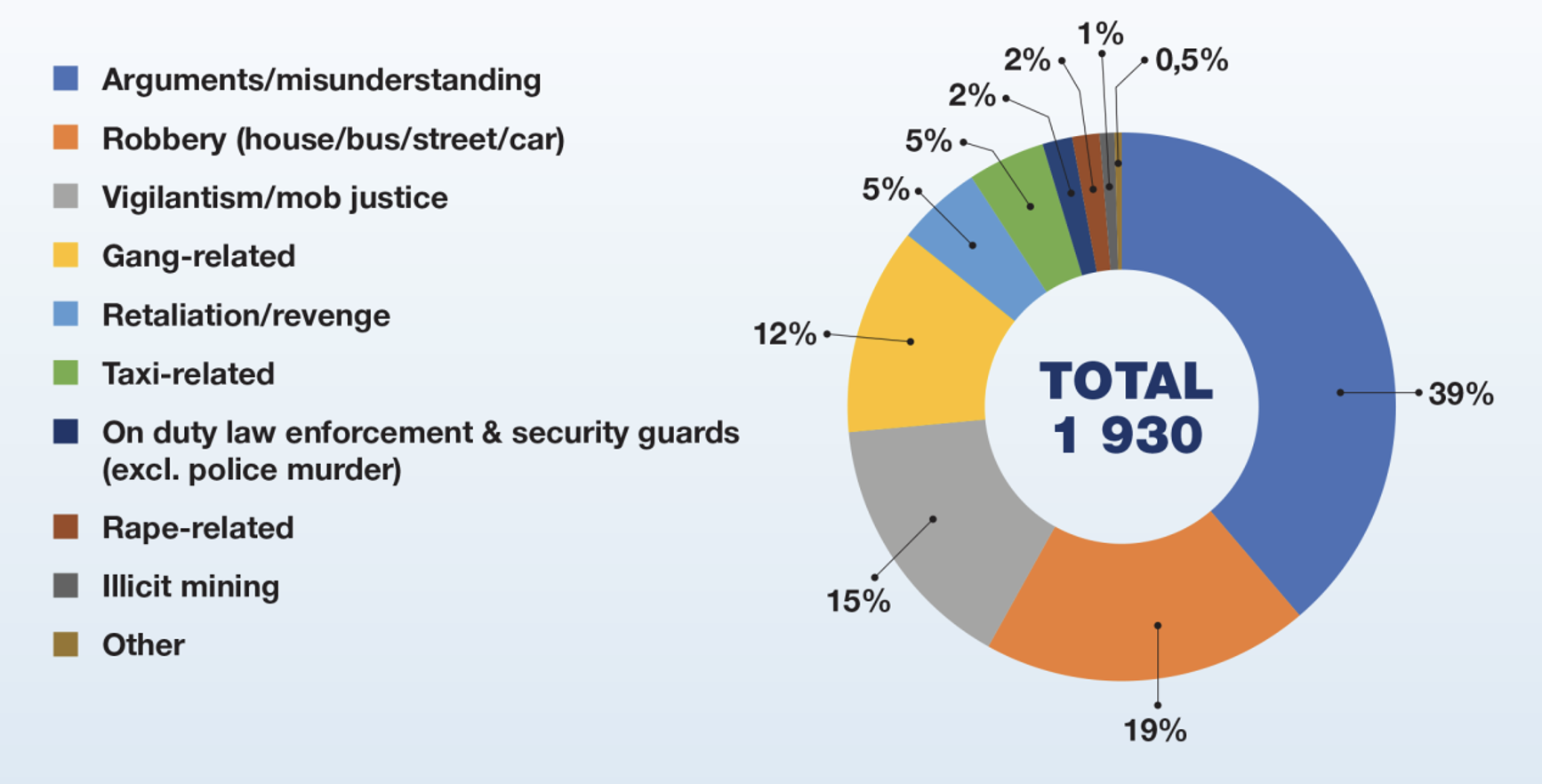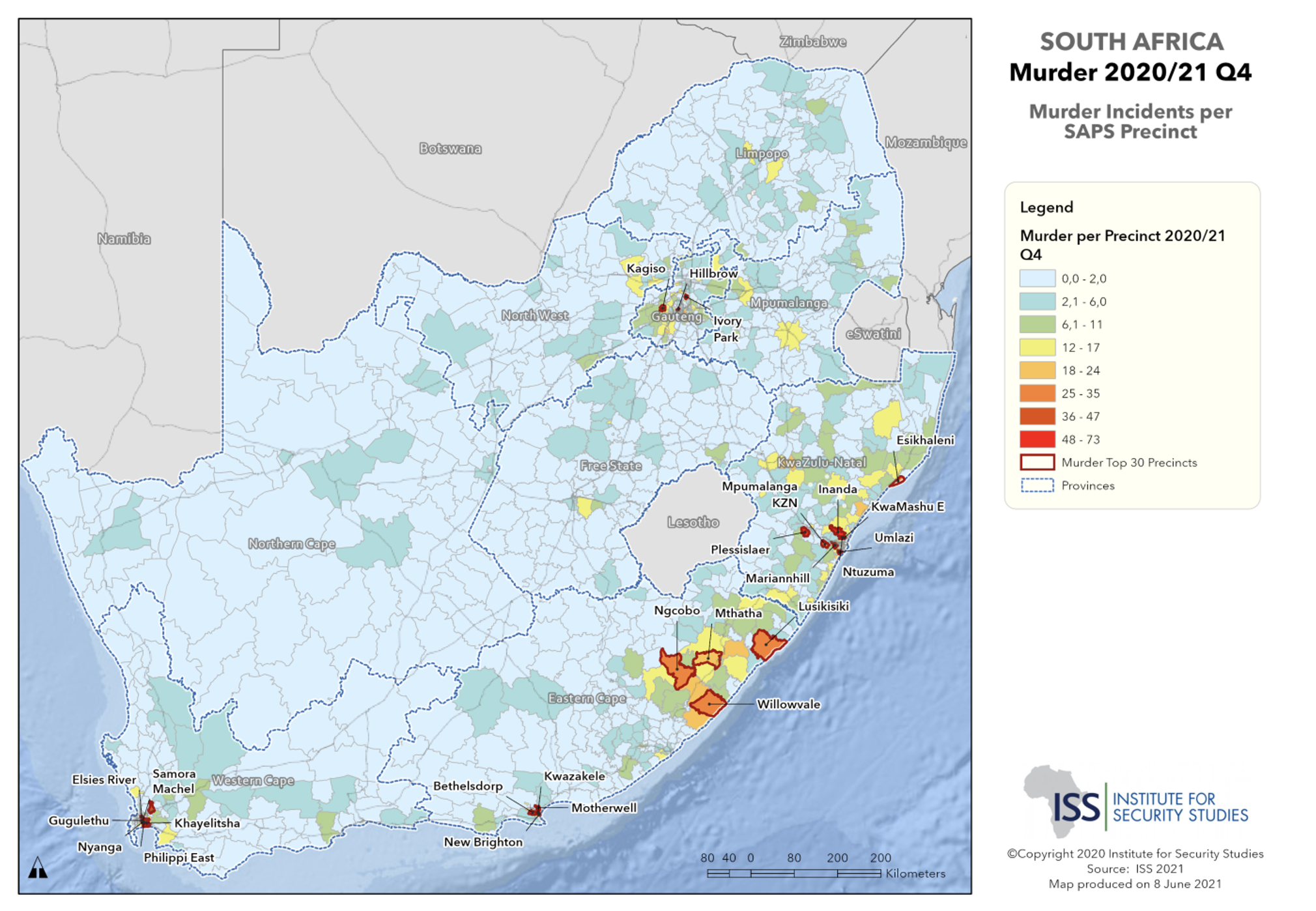South Africa needs a murder reduction strategy
The latest trends suggest a violent future for the country, which still has no national plan to tackle murder.
Despite a year of lockdown restrictions, which saw fewer offences being committed, crime and violence levels in South Africa are again rising. Most crime, but mainly that which is violent and organised, looks likely to worsen if there are no fundamental improvements in policing.
An analysis of police data shows that in March – the most recent month for which crime data is available – overall violent crime levels matched those in previous years (Figure 1). For some categories such as murder, they were higher. This is bad news given that between April and June 2020, violent crime dropped by 37% compared to the previous year.
This decrease was probably due to the severe restrictions on movement and economic activity under COVID-19 lockdowns. However, as the controls were eased, serious violent crime began to rise. This trend was predicted by the Institute for Security Studies (ISS) in June 2020 because the factors that drive crime in South Africa weren’t being addressed.
Figure 1: Total violent crime in South Africa, by month, Jan 2018 – March 2021  Source: ISS Crime Hub Source: ISS Crime Hub(click on the graph for the full size image)
|
The ISS’s Crime Hub presents statistics for 29 crime types nationally, provincially, per district, per municipality and for each of the 1 154 police precincts in the country. In addition, crime figures are now available for each month starting in 2016. This is a welcome improvement as detailed data hasn’t always been made public.
Police Minister Bheki Cele announced in 2020 that the South African Police Service (SAPS) would release crime statistics quarterly. The 1 April – 30 June 2020 quarter was the first period for which monthly crime figures were made available.
If the current trajectory continues, we may well soon experience much higher violence levels. This is a daunting prospect in a country where murder and armed robbery increased by 37% and 43% respectively in the eight years leading up to March 2020. This is particularly worrying because the national murder rate has increased by over 20% since 2011/12.
These increases are probably the consequence of a combination of factors such as socio-economic deterioration, urbanisation, increased inequality, declining police performance and high levels of police corruption. A main driver of murder in many areas is the availability of illegal firearms, which is often interlinked with organised crime networks.
Given this, it is remarkable that South Africa doesn’t have a clear strategy to tackle murder. Reducing the factors contributing to murder would probably bring down violence more generally. The key is to understand what drives murder in particular areas.
Figure 2 shows the circumstances in which murders were committed in the first three months of 2021. The data is based on the 40% of murder cases in which the police had enough information to decide on possible causes.
Figure 2: Circumstances leading to murder, January – March 2021  Source: ISS Crime Hub Source: ISS Crime Hub(click on the graph for the full size image)
|
In 39% of cases (where police could establish a motive), the cause could be attributed to arguments and misunderstandings, often between acquaintances or relatives. This is a testament to how normalised violence is in everyday life. The second most common circumstance in which murders were committed was during a robbery (19%).
Given the frustration levels in high-crime communities, it is not surprising that vigilantism was the third most noted cause at 15%. Murders attributed to gangs, taxi conflict and illicit mining violence together made up 18%. If this proportion is added to robberies, as many as 52% of murders (where causes could be established) relate to organised crime and inter-group violence.
Unfortunately, the police’s ability to solve murders has declined by 38% since 2011/12, with the result that in 2019/20, detectives were only able to solve 19 out of every 100 murders. The record for aggravated robbery is worse, with only 17% being solved.
The enforcement of the lockdown regulations may have distracted police from removing illegal firearms and tackling criminal networks. It would appear that organised crime groups took advantage of this and strengthened as a result. The police’s crime intelligence capability has also declined, decimated by years of factional battles, political interference, corruption and weak police leadership. This means we can probably anticipate ongoing increases in murder and robbery in the short to medium term.
A large portion of murder and aggravated robbery occurs in predictable places and times. Figure 3 shows the 30 policing precincts that recorded the highest murders between January and March 2021. These make up only 2.6% of police stations in the country but accounted for 22.5% of all murders during this period. They are mainly located in South Africa’s larger metros. Most attacks occurred over weekends and in identifiable hotspots.
Figure 3: Police precincts with the highest murders, Jan – March 2021  Source: ISS Crime Hub Source: ISS Crime Hub(click on the map for the full size image)
|
Much of South Africa’s violent crime can be reduced if police analyse their data together with information from other sources (such as ambulance pick-ups and hospitals). This will enable an understanding of what drives violence in high murder precincts. Police operations need to be concentrated on particular issues (such as removing illegal firearms and closing illegal alcohol outlets), people (such as repeat offenders), and places.
Targeted policing and a ‘whole of society’ approach advocated in the 2016 White Paper on Safety and Security could reduce violence in hotspots. For example, local government’s role involves not only enforcing traffic laws but providing services and safe public spaces so that commuters have safe and well-lit walkways. Municipalities can also provide shelters for victims of domestic violence. The meaningful involvement of community organisations is critical for local interventions to work.
A focus on tackling organised crime is vital to reducing violence in South Africa. Organised crime syndicates work across local and often national boundaries. The SAPS urgently needs a national plan to deal with organised crime at the local, provincial and country level. Dedicated investigators operating across police jurisdictions are essential.
The success of the Family Violence, Child Protection and Sexual Offences investigation teams show that dedicated units are effective in dealing with specific crimes. Speaking at a recent ISS seminar, SAPS Divisional Commissioner responsible for visible policing and operations, Lieutenant General Michael Mohlala, suggested that specialised anti-gang and murder and robbery units may be on the cards. This cannot come soon enough for weary South Africans.
Lizette Lancaster, Crime Hub Manager, Justice and Violence Prevention, ISS Pretoria
In South Africa, Daily Maverick has exclusive rights to re-publish ISS Today articles. For media based outside South Africa and queries about our re-publishing policy, email us.

